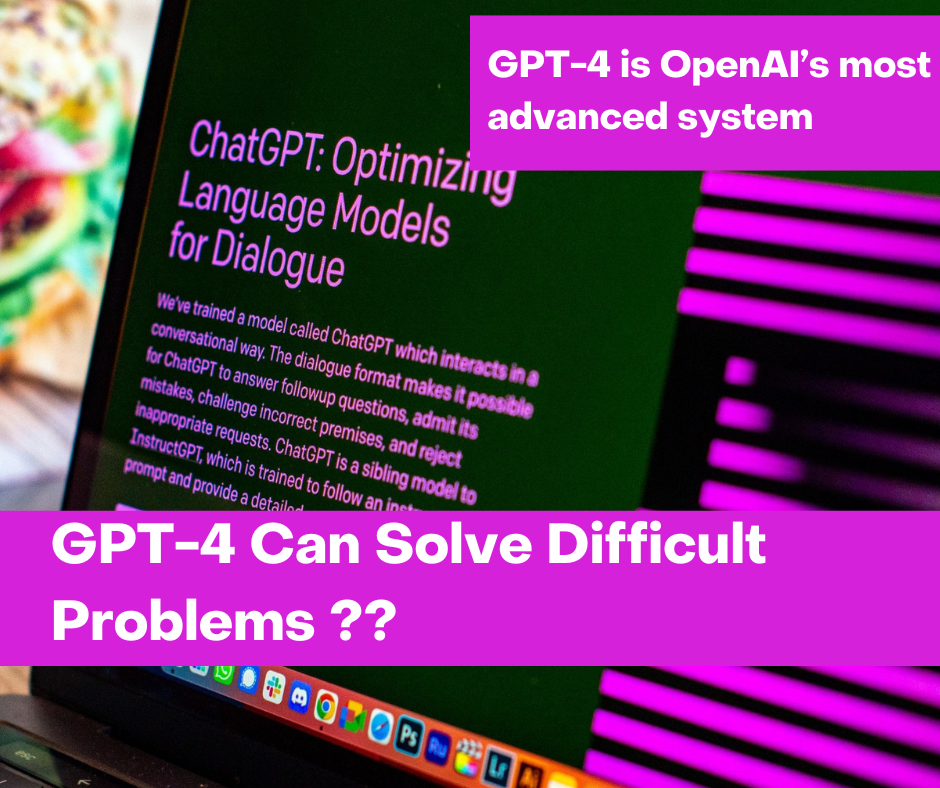Table of Contents
GPT-4 Can Solve Difficult Problems: A Closer Look at OpenAI’s Latest Breakthrough
As technology continues to advance, artificial intelligence (AI) has become an increasingly important part of our lives. One of the most exciting developments in this field is the OpenAI GPT-4 model, which promises to solve difficult problems with greater accuracy than ever before. In this article, we will take a closer look at the GPT-4 model and explore its potential impact on our world.

What is the GPT-4 Model?
The GPT-4 model is the latest iteration of the Generative Pre-trained Transformer (GPT) language model developed by OpenAI, a research organization dedicated to advancing AI in a safe and responsible manner. Like its predecessors, GPT-4 is a large-scale neural network trained on vast amounts of text data, allowing it to generate human-like responses to prompts and questions.
However, GPT-4 is unique in its ability to solve more complex and challenging problems than previous versions. According to OpenAI, GPT-4’s broader general knowledge and problem-solving abilities give it greater accuracy and flexibility, making it well-suited for a wide range of tasks.
How Does GPT-4 Solve Difficult Problems?
GPT-4’s improved problem-solving capabilities are due in part to its use of unsupervised learning techniques. Unlike supervised learning, which requires labeled training data, unsupervised learning allows the model to learn from unstructured data without explicit guidance.
This means that GPT-4 can identify patterns and relationships in data that may not be immediately apparent to human observers. By recognizing these patterns, GPT-4 can generate more accurate and nuanced responses to complex problems.
What Can GPT-4 Be Used For?
OpenAI envisions GPT-4 being used for a wide range of applications, from natural language processing and language translation to more complex tasks like scientific research and medical diagnosis. In fact, one of the most exciting potential uses for GPT-4 is in the field of creativity, where it can collaborate with humans to generate new and innovative ideas.
For example, GPT-4 can be used to generate and edit creative writing, such as novels or screenplays. It can also be used in the design process to generate new product ideas or iterate on existing ones. The possibilities are endless, and we are only just beginning to scratch the surface of what GPT-4 can do.
What Are the Implications of GPT-4 for AI and Society?
The implications of GPT-4 for AI and society are profound. On the one hand, GPT-4 represents a significant leap forward in AI capabilities, bringing us closer than ever before to the long-held dream of creating truly intelligent machines. On the other hand, GPT-4’s advanced abilities raise important questions about the ethical and social implications of AI.
For example, as AI becomes more capable, it may start to replace human workers in certain industries. This could lead to widespread job loss and economic disruption. Additionally, as AI becomes more powerful, it may become increasingly difficult to control and regulate, leading to concerns about safety and security.
Conclusion
In conclusion, the GPT-4 model represents a major breakthrough in the field of artificial intelligence. With its improved problem-solving capabilities and broader general knowledge, GPT-4 has the potential to revolutionize a wide range of industries and applications. However, as with any new technology, there are important ethical and social considerations that must be taken into account. As we continue to develop and refine AI technologies like GPT-4, it is essential that we do so in a responsible and ethical manner.
FAQs
- What is ChatGPT-4? ChatGPT-4 is a new language model developed by OpenAI that is an advanced version of ChatGPT. It can generate text that is similar to human speech and is designed to have a broader general knowledge and problem-solving abilities compared to its predecessors. [[1]]
- How does ChatGPT-4 work? ChatGPT-4 is fine-tuned from GPT-3.5, a language model trained to produce text. It is optimized for dialogue by using Reinforcement Learning with Human Feedback (RLHF) – a method that uses human demonstrations and preference comparisons to guide the model toward desired behavior. [[1]]
- What are the new features of ChatGPT-4? ChatGPT-4 is more creative and collaborative than ever before. It can generate, edit, and iterate with users on creative and technical writing tasks, such as coding and game development. It is designed to have broader general knowledge and problem-solving abilities, allowing it to solve more difficult and complex problems with better accuracy. [[2], [3]]
- What is the difference between ChatGPT-4 and its predecessor, ChatGPT? ChatGPT-4 is designed to have broader general knowledge and problem-solving abilities compared to its predecessors, making it more advanced and accurate. It is also more creative and collaborative, with the ability to generate, edit, and iterate with users on various writing tasks. [[1], [2], [3]]
- How can ChatGPT-4 be used? ChatGPT-4 can be used in a variety of applications, including chatbots, virtual assistants, content creation, and natural language processing. Its advanced features and capabilities make it a valuable tool for businesses, researchers, and developers. [[2], [3]]
References
[1] “How does ChatGPT work? ChatGPT is fine-tuned from GPT-3.5, a language model trained to produce text. ChatGPT was optimized for dialogue by using Reinforcement Learning with Human Feedback (RLHF) – a method that uses human demonstrations and preference comparisons to guide the model toward desired behavior.”
URL: https://help.openai.com/en/articles/6783457-chatgpt-general-faq
[2] “FAQ’s. What is ChatGPT 4.0? ChatGPT is an advanced language model developed by OpenAI that can generate human-like responses to text-based prompts. It is a state-of-the-art machine learning algorithm that uses deep learning techniques to understand and respond to natural language queries.”
URL: https://prochatgpt.net/chatgpt-4-0/
[3] “GPT-4 is a new language model created by OpenAI that can generate text that is similar to human speech. It will advance the technology used by ChatGPT, which is currently based on GPT-3.5. GPT is …”
URL: https://www.digitaltrends.com/computing/chatgpt-4-everything-we-know-so-far/